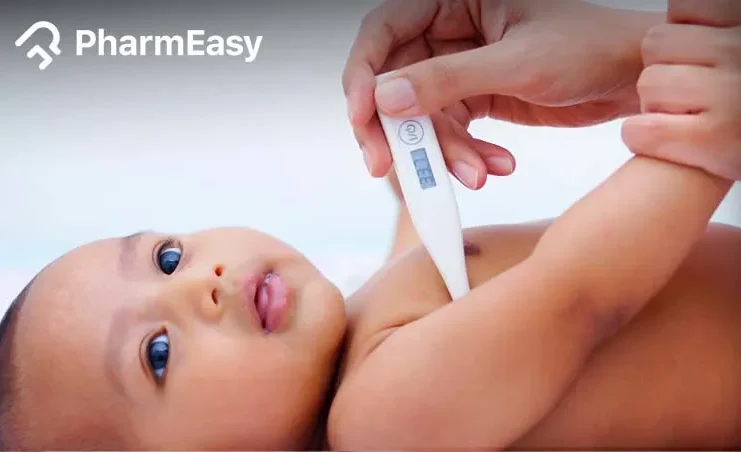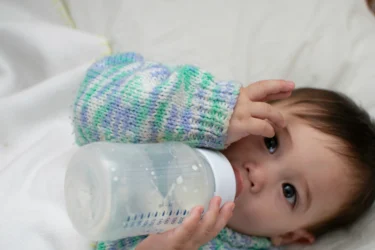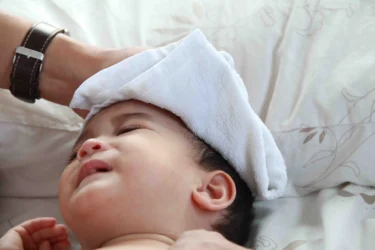Normal Body Temperature for Babies: A Complete Guide for Parents
By Dr. Anmol Batra +2 more

Get,

to manage your symptom
Get your,


4 Cr+ families
benefitted

OTP sent to 9988776655



You’ve successfully subscribed to receive
doctor-approved tips on
Whatsapp

Get ready to feel your best.

Hi There,
Download the PharmEasy App now!!


Register to Avail the Offer
Send OTPBy continuing, you agree with our Privacy Policy and Terms and Conditions

Hi There,
Sign up on PharmEasy now!!
Trusted by 4 crore+ families

OTP sent to 9988776655



You have unlocked 25% off on medicines




Code: NU25
By Dr. Anmol Batra +2 more
Table of Contents
The normal temperature for babies is usually around 36 to 37°C (96.8 to 98.6°F) and may rise higher, causing a fever which can be due to infections or illnesses. Fever is one of the most common reasons parents seek medical advice for their children, whether during routine visits or emergency consultations1.
It is natural for parents to feel alarmed when their baby develops a fever. But it’s important to note that mild fluctuations in temperature are common and usually not a cause for concern. However, persistent high or unusually low readings should not be ignored, as they may indicate an underlying condition. Therefore, monitoring your baby’s temperature is important, as it helps distinguish between a mild, self-limiting illness and a potentially serious infection requiring medical attention2.

Through this guide, we aim to help you understand when to monitor, when to wait, and when to seek medical care if you notice a change in your baby’s body temperature.
As mentioned earlier, a baby’s normal body temperature usually ranges between 36°C and 37°C (96.8 to 98.6°F).
A fever is defined as a temperature of 38°C (100.4°F) or higher in babies under three months, and 38.5°C (101.3°F) or higher in older children1.
As a parent/caregiver, it is important to remember that body temperature can naturally vary depending on several factors, such as:
Note: Temperature readings may vary slightly depending on the method used (oral, forehead, ear, or rectal)4. Therefore, for the most accurate results, a thermometer placed in the rectum is recommended for infants1.
Parents must recognize that a rectal temperature of 100.4°F (38.0°C) or higher in any infant under 28 days old is an absolute medical emergency requiring immediate presentation to the hospital, regardless of how well the baby is feeding or appearing, as this warrants an urgent workup for neonatal sepsis4.
Dr. Sarthak Soni, MBBS, MD (Pediatrics)
As discussed above, infant fever is defined as a body temperature of ≥38°C (100.4°F). Based on its intensity, it can be classified as1,2:
It is crucial to remember that fever is usually a symptom, not a disease, and often indicates that the body’s immune system is responding to certain triggers, such as germs1,2. Common triggers include1:
Note: While fever itself is not always dangerous and the body can often fight it off without medical intervention, it is important for parents to monitor the underlying cause and seek medical care if the baby shows other concerning symptoms.
Parents can often recognise a fever in a baby just by observing them. Common signs and symptoms include1,3:
Note: If you’re wondering how to know if infant has fever, the most reliable way is by using a thermometer rather than relying on touch.
Knowing about fever in babies and when to worry helps parents seek medical care without delay:
It is important to seek immediate medical attention if your baby1,3:
Important: Never delay seeking medical help if your baby’s fever temperature meets the age-specific thresholds or if any concerning symptoms appear.
A common question is how to know an infant has a fever; the key is to monitor regularly using the right thermometer for their age.
Parents can choose from different types of thermometers to measure a baby’s temperature:
There are several methods to measure a baby’s temperature, and the choice depends on the baby’s age, comfort, and the level of accuracy needed7:
Here is a list of recommended methods by age7:
| Age | First Choice | Second Choice | Third Choice |
| Birth to 2 years | Rectum | Armpit | NIL |
| 2 to 5 years | Rectum | Ear | Armpit |
| Older than 5 years | Mouth | Ear | Armpit |
Below is the range of normal body temperature for babies by method7:
| Method | Normal Range |
| Rectum | 36.6°C to 38°C (97.9°F to 100.4°F) |
| Mouth | 35.5°C to 37.5°C (95.9°F to 99.5°F) |
| Armpit | 34.7°C to 37.3°C (94.5°F to 99.1°F) |
| Ear | 35.8°C to 38°C (96.4°F to 100.4°F) |
Follow these step-by-step instructions to measure your baby’s temperature safely and accurately7:
Tips
Note: For infants and young children, accuracy is more important than convenience. Always use the most reliable method (typically rectal) to ensure correct temperature measurement.
Before measuring fever at home it is important for parents that child should not be excessively covered by clothes, as it may lead to false high reading of temperature. Hence before measuring remove the clothes, winter jackets if there and then measure after some time.
Dr. Sarthak Soni, MBBS, MD (Pediatrics)
Most babies with a fever can be cared for safely at home, as long as there are no signs of a serious illness. The goal is to keep your baby comfortable and well-hydrated. Here are some tips to follow:


Also Read: How to Stop Constant Cough in Children: Expert Tips and Tricks

Important: If you are considering giving your baby fever-reducing medication, always consult your paediatrician first. Only use doctor-prescribed medications and follow the recommended dosage instructions carefully.
Also Read: Super Easy Yoga Poses for Kids to Try at Home
The normal body temperature in babies generally ranges from 36 to 37°C (96.8 to 98.6°F) and small fluctuations in this range are usually normal. Fever is typically defined as a body temperature of 38°C (100.4°F) or higher and is fairly common in babies and young children. Therefore, careful monitoring is essential to identify when a baby may need medical attention.
If the fever persists, becomes very high, or is accompanied by concerning symptoms, parents should seek prompt medical advice. Remember, attentive care, reassurance, and gentle observation are the best ways to support your baby.
Also Read: Nasal Drops for Babies and Kids: Types, Uses, and Safety Guide
A warning temperature is generally 38°C (100.4°F) or higher in infants under 3 months, and 38.5°C (101.3°F) or higher in older babies1.
Normal body temperature in babies is usually 36 to 37°C (96.8 to 98.6°F). It is important to understand that small fluctuations within this range are common and usually not a cause for concern1.
37.5°C is slightly above average but not considered a fever1. It is within a low-grade range and often normal.
No, 99°F (37.2°C) is slightly elevated but not considered a fever. Fever typically starts at 100.4°F (38°C) or higher in young infants1.
Disclaimer: The information provided here is for educational/awareness purposes only and is not intended to be a substitute for medical treatment by a healthcare professional and should not be relied upon to diagnose or treat any medical condition. The reader should consult a registered medical practitioner to determine the appropriateness of the information and before consuming any medication. PharmEasy does not provide any guarantee or warranty (express or implied) regarding the accuracy, adequacy, completeness, legality, reliability or usefulness of the information; and disclaims any liability arising thereof.
Links and product recommendations in the information provided here are advertisements of third-party products available on the website. PharmEasy does not make any representation on the accuracy or suitability of such products/services. Advertisements do not influence the editorial decisions or content. The information in this blog is subject to change without notice. The authors and administrators reserve the right to modify, add, or remove content without notification. It is your responsibility to review this disclaimer regularly for any changes.
Comments

Leave your comment...
You may also like
Comments